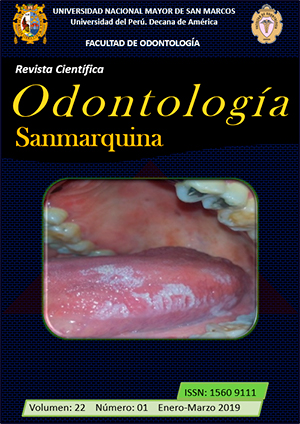Apical microfiltration between three cements used in retrograde obturation
DOI:
https://doi.org/10.15381/os.v22i1.15860Keywords:
Microfiltration, Retrograde obturation, Sodium hypochloriteAbstract
Objective: To determine the apical microfiltration of three cements used in retrograde obturation. Methods: 45 monoradicular pieces standardized to 16 mm in length were instrumented with manual ProTaper® system and irrigated with 5.25% NaClO. The samples were sealed with ProTaper® F3 main cone and Denstply® accessories #A and #B; an apical recession of 3 mm was performed, subsequently a 3 mm of obturation was removed with ultrasound (Satelec Acteon) using tip s12/70D; the samples were divided into three groups to perform retrograde filling, each with different sealing cements. The samples were incubated at 37°C for 3 days; then covered with nail varnish except 2 mm apical to be immersed in 1% methylene blue for 48 hours, washed and longitudinally cut with #2 diamond disc for analysis in the stereo microscope (EduBlue ED 1402S), with the help of a micrometer (Stainless Hardened); different values of each group were obtained, then analyzed through comparison of means and parametric tests. Results: The average evaluation of the microfiltration produced by the retrograde filling indicates that: the MTA® presented a value of 87.33 ± 9.61 μm (14.57%), followed by the Biodentine ® with 136 ± 12.42 μm ( 22.69%), compared to the IRM® with the highest amount of microfiltration with a value of 376 ± 12.98 μm (62.74%). Conclusions: When comparing the means and percentages of the apical microfiltration of the IRM®, Biodentine® and MTA® cements; it was evident that the MTA® showed the lowest microfiltration value.
Downloads
Downloads
Published
Issue
Section
License
Copyright (c) 2019 Vinicio Vladimir Legarda Canales, Isadora Martini Garcia, Paola Andrea Mena Silva, Viviana Marcela Hidalgo Moya, Raquel Esmeralda Guillén Guillén

This work is licensed under a Creative Commons Attribution-NonCommercial-ShareAlike 4.0 International License.
AUTHORS RETAIN THEIR RIGHTS:
a. Authors retain their trade mark rights and patent, and also on any process or procedure described in the article.
b. Authors retain their right to share, copy, distribute, perform and publicly communicate their article (eg, to place their article in an institutional repository or publish it in a book), with an acknowledgment of its initial publication in the Odontología Sanmarquina.
c. Authors retain theirs right to make a subsequent publication of their work, to use the article or any part thereof (eg a compilation of his papers, lecture notes, thesis, or a book), always indicating the source of publication (the originator of the work, journal, volume, number and date).




















